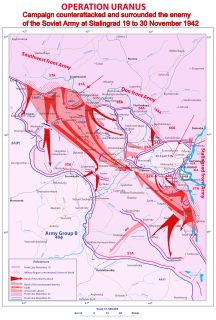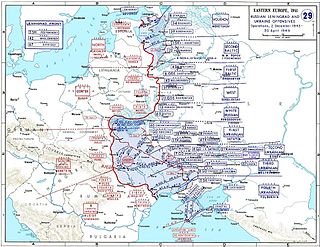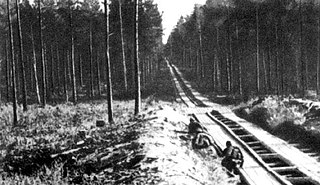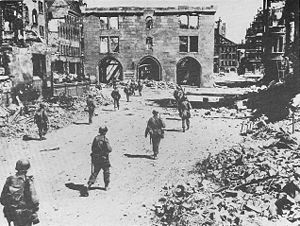
Operation Dragoon was the code name for the Allied invasion of the French Riviera. Originally planned to coincide with D-Day, it had been postponed due to insufficient landing-craft. In August, it was revived, as the zone had become a low priority for the Germans, and conditions looked favourable for the liberation of Southern France with its key ports of Marseille and Toulon.

Operation Uranus was the codename of the Soviet 19–23 November 1942 strategic operation in World War II which led to the encirclement of the German Sixth Army, the Third and Fourth Romanian armies, and portions of the German Fourth Panzer Army. The operation was executed at roughly the midpoint of the five month long Battle of Stalingrad, and was aimed at destroying German forces in and around Stalingrad. Planning for Operation Uranus had commenced in September 1942, and was developed simultaneously with plans to envelop and destroy German Army Group Center and German forces in the Caucasus. The Red Army took advantage of the German army's poor preparation for winter, and the fact that its forces in the southern Soviet Union were overstretched near Stalingrad, using weaker Romanian troops to guard their flanks; the offensives' starting points were established along the section of the front directly opposite Romanian forces. These Axis armies lacked heavy equipment to deal with Soviet armor.

The European theatre of World War II, also known as the Second European War, was a huge area of heavy fighting across Europe, from Germany's invasion of Poland on 1 September 1939 until the end of the war with the Soviet Union conquering most of Eastern Europe along with the German unconditional surrender on 8 May 1945. The Allied powers fought the Axis powers on two major fronts as well as in a massive air war and in the adjoining Mediterranean and Middle East theatre.

The 16th Armored Division was an armored division of the United States Army in World War II. In its one and only combat operation, the 16th Armored Division liberated the city of Pilsen in western Czechoslovakia, an operation that influenced the landscape of post-war Europe.

The Western Front was a military theatre of World War II encompassing Denmark, Norway, Luxembourg, Belgium, the Netherlands, the United Kingdom, France, Italy, and Germany. World War II military engagements in Southern Europe and elsewhere are generally considered under separate headings. The Western Front was marked by two phases of large-scale combat operations. The first phase saw the capitulation of the Netherlands, Belgium, and France during May and June 1940 after their defeat in the Low Countries and the northern half of France, and continued into an air war between Germany and Britain that climaxed with the Battle of Britain. The second phase consisted of large-scale ground combat, which began in June 1944 with the Allied landings in Normandy and continued until the defeat of Germany in May 1945.
Army Group Centre was the name of two distinct strategic German Army Groups that fought on the Eastern Front in World War II. The first Army Group Centre was created on 22 June 1941, as one of three German Army formations assigned to the invasion of the Soviet Union. On 25 January 1945, after it was encircled in the Königsberg pocket, Army Group Centre was renamed Army Group North, and Army Group A became Army Group Centre. The latter formation retained its name until the end of the war in Europe.

Case Blue was the German Armed Forces' name for its plan for the 1942 strategic summer offensive in southern Russia between 28 June and 24 November 1942, during World War II.

The Prague Offensive was the last major military operation of World War II in Europe. The offensive was fought on the Eastern Front from 6 May to 11 May 1945. Fought concurrently with the Prague uprising, the offensive was one of the last engagements of World War II in Europe and continued after Nazi Germany's unconditional capitulation on 8 May.

The 9th Army was a World War II field army. It was activated on 15 May 1940 with General Johannes Blaskowitz in command.
The 6th Panzer Army was a formation of the German Army, formed in the autumn of 1944. The 6th Panzer Army was first used as an offensive force during the Battle of the Bulge, in which it operated as the northernmost element of the German offensive. The army was subsequently transferred to Hungary in early 1945 and used in both offensive and defensive actions there. The final battles of the 6th Panzer Army were fought in Austria until the collapse of Nazi Germany, at which point the army was completely demoralized. The remnants of the army eventually surrendered to the United States Army. Army commander throughout the army's existence, SS-Oberstgruppenführer Josef Dietrich said in early 1945:
"We call ourselves the "6th Panzer Army", because we've only got 6 Panzers left".
The 44th Infantry Division was formed on 1 April 1938 in Vienna, about two weeks after the Anschluss of Austria. It first saw combat at the start of the war in the Invasion of Poland, and also took part in the Battle of France in 1940. After a 9-month period of coastal defence the division was transferred East. On 22 June 1941, the division took part in the invasion of the Soviet Union, attached to Army Group South. It remained in the east after the failure of "Operation Barbarossa", taking part in defensive actions for the winter against the Soviet Army offensives near Izum and Karkov. Refurbished, the division participated in the German summer offensive, and was subsequently destroyed with the 6th Army at Stalingrad in January 1943.

The Siege of Breslau, also known as the Battle of Breslau, was a three-month-long siege of the city of Breslau in Lower Silesia, Germany, lasting to the end of World War II in Europe. From 13 February 1945 to 6 May 1945, German troops in Breslau were besieged by the Soviet forces which encircled the city as part of the Lower Silesian Offensive Operation. The German garrison's surrender on 6 May was followed by the surrender of all German forces two days after the battle.

The Courland Pocket was a group of German forces of Reichskommissariat Ostland on the Courland Peninsula that was cut off and surrounded by the Red Army from July 1944 through May 1945.

The Western Allied invasion of Germany was coordinated by the Western Allies during the final months of hostilities in the European theatre of World War II. In preparation for the Allied invasion of Germany, a series of offensive operations were designed to seize and capture the east and west bank of the Rhine River. Operation Veritable and Operation Grenade in February 1945, and Operation Lumberjack and Operation Undertone in March 1945. Allied invasion of Germany started with the Western Allies crossing the Rhine River on 22 March 1945 before fanning out and overrunning all of western Germany from the Baltic in the north to Austria in the south before the Germans surrendered on 8 May 1945. This is known as the "Central Europe Campaign" in United States military histories.
The Nagykanizsa–Körmend Offensive carried out between 26 March and 15 April 1945 was part of the 3rd Ukrainian Front's Vienna Offensive during World War II against the Army Group South forces defending the Kisbajom-Nagykorpád-Nagyatád-Heresznye defensive line north of the Drava river and west of Lake Balaton.

The Dnieper–Carpathian Offensive, also known in Soviet historical sources as the liberation of right-bank Ukraine, fought from 24 December 1943 – 17 April 1944, was a strategic offensive executed by the 1st, 2nd, 3rd, and 4th Ukrainian Fronts, along with the 1st Belorussian Front, against the German Army Group South, intended to retake all of the Ukrainian and Moldovian territories occupied by Axis forces.
This is a timeline of the events that stretched over the period of World War II from January 1945 to its conclusion and legal aftermath.

The Sinyavino Offensive was an operation planned by the Soviet Union in the summer of 1942 with the aim of breaking the Siege of Leningrad, which had begun the previous summer, and establish a reliable supply line to Leningrad. At the same time, German forces were planning Operation Northern Light to capture the city and link up with Finnish forces. To achieve that heavy reinforcements were arriving from Sevastopol, which the German forces captured in July 1942. Both sides were unaware of the other's preparations, and this made the battle unfold in an unanticipated manner for both sides.

The 422nd Rifle Division was formed for the first time as a standard Red Army rifle division late in 1941, after the Soviet winter counteroffensive had begun, but was soon re-designated. A second formation began in March, 1942, again in the far east of Siberia, until July, after which it was moved west to join the reserves of Stalingrad Front in August. It was the highest-numbered rifle division to see active service in the front lines during the Great Patriotic War. Over the course of the next six months, the division distinguished itself in both defensive and offensive fighting and earned its re-designation as the 81st Guards Rifle Division on the first day of March, 1943. The 422nd was never reformed.
The 7th Guards Tank Division was a tank division of the Soviet Army during the Cold War.

















